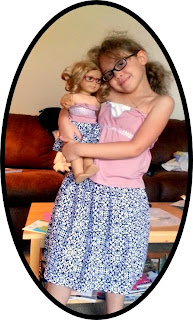Creating the Golden Goddess Skirt
Okay, so this is the first adult-sized project. I made a few oopsies. But I think everything will turn out in the end.
Although I wanted to finish the skirt while my Sweet Sistah was still in town, I realized it might be better to get it mostly done, fit it on her, mark adjustments, and put on the final details when she comes in town before the wedding. That's my story, and I'm sticking to it.
Drafting the Pattern
First, I took measurements, and using the chart in Sew What? Skirts! drafted the pattern on graph paper. I like to use graph paper because it is sturdy (which is good when you're cutting the fabric), and it's easy to see whether your seams are trued and your lines are straight.However, it is not good for "tissue fitting" your pattern (i.e,, when you pin the pattern pieces together on the body to check fit and make adjustments). More on this later.
I had a bit of trouble with one aspect of the pattern drafting. I curved the bottom hem to match the curve in the waistband, but then couldn't true the side seam line--it just wouldn't work the way the instructions said it would.
I think A-line skirts are easier to draft.
So, I fudged it a little bit.
Cutting the Fabric
Before cutting, I just wanted to eyeball the fit--here is where pattern tissue paper would have been better.Oh, no! it looks too narrow! Maybe I didn't add enough ease?
Sweet Sistah wanted it fitted, not loose, so where it said "add 2-4 inches of ease," (hip measurement) I added 2. Where it said "add 1-2 inches of ease," (waist measurement) I added 1.
[I partly made this decision based on the results of The Cotton Candy Skirt. Although I had intended a fitted waistband, the amount of ease suggested in the pattern drafting instructions made it too large, so I had to use elastic.]
Since the pattern looked so small, I decided to add an additional 1/2 inch seam allowance at the side when cutting the fabric--a total of 2 inches around. I didn't want to do a lot of work only to have it not fit at all!
 |
| {Basting Darts-- Golden Goddess Skirt} |
Basting the Darts
The first sewing task was to baste and sew the darts.
My Mom had given me some tips over the phone:
- While basting the darts, take one stitch on one side of the dart leg--from the top towards the point--then cross to the other side, continuing in the same direction, and take another stitch.
- Keep alternating sides with each stitch.
- When you get to the point, pull the thread taut--magic! a perfectly formed dart.
 |
| {Basting Darts--Golden Goddess Skirt} |
No need to try to fold slippery fabric and pin!
- Now, just sew from top to bottom of the dart (on the inside of course), making sure to sew off the edge of the fabric at the point.
- Remove the basting threads.
Voila--simple, perfect, beautiful darts!
 |
| {Basting Darts--The Golden Goddess Skirt. The dart still looks a bit puckered, since I machine basted but haven't sewn final stitches or pressed yet.} |
Basting the Side Seams
Now, I simply basted the side seams, and gave the skirt to Sweet Sistah to try on. |
| {Golden Goddess Skirt: Basted Side Seam} |
WTF! IT'S LIKE FOUR INCHES TOO BIG EVERYWHERE!
So much for the pattern looking too small.
We held the skirt in place, and I pinned on both sides where the seams should have been.
I removed the skirt and roughly marked the pin line with fabric marker. (Well, I'm calling it fabric marker; it's really just cheap kid's washable marker--it washes out super easily!)
 |
| {Golden Goddess Skirt: Basted Side Seam with Adjustment Marked} |
Then, I traced roughly along those lines with marker. In theory, I should be able to just re-baste along those lines, right?
Maybe. Or, possibly, wrong!!
The problem is, if I do that I won't be able to use the paper pattern for cutting the overskirt. Also, because of the pinning and marking, the distance between the original seam line and the new seam line may not be identical on both sides.
Maybe I shouldn't be so particular? I know it will fit, at least.
But maybe it will end up looking lopsided? What if the distance between the seams and darts are not symmetrical across all four quadrants of the body?
 |
| {The Golden Goddess Skirt: Sudden Dart/Fitting Angst. This photo is appropriately F-d up!} |
This is what Sweet Sistah said would happen. It would come out lopsided, but I (and now everyone) would feel obligated to wear it anyway.
These were supposed to be special, hand-created garments, gifts, to be worn proudly!
CRAP I hate it when naysayers are actually right!
On the other hand, if I do simply re-baste and pull out the original basted seams, then I can use the skirt itself as the pattern for the overskirt.
Or, even better, since the overskirt is supposed to be a bit wider than the underskirt--kind of a floaty, sheer, layer--maybe all I have to do is measure the new waistline after I've adjusted the skirt, and gradually connect the new waistline to the old hipline on the paper pattern.
I'm a genius!
It's amazing how writing about something suddenly solves all of its problems.
All week, I've been trying to figure this out. I had at least three more-complicated ways of figuring this out. Since I couldn't face it, I set it aside.
Now, instead of having three skirts finished in a week, as I had planned, I only have one slightly messed-up one, that's still not finished.
But now I know how to fix it!
Till next time,--Ayana






























